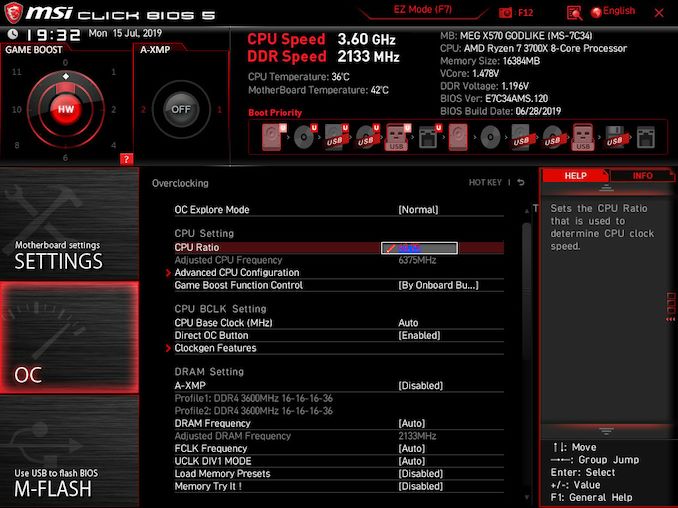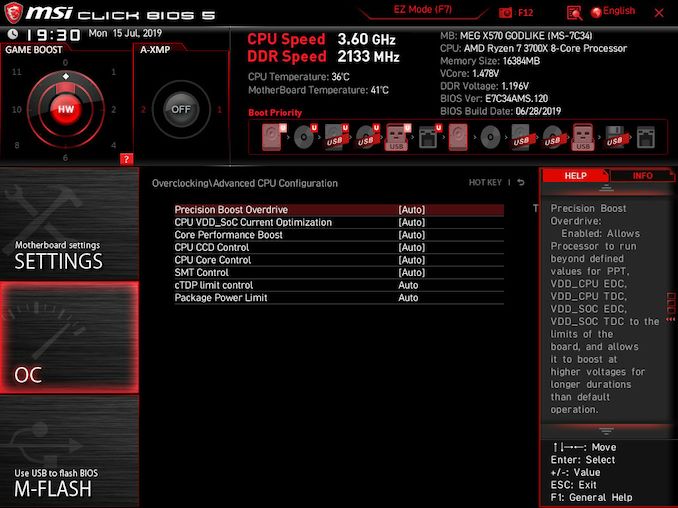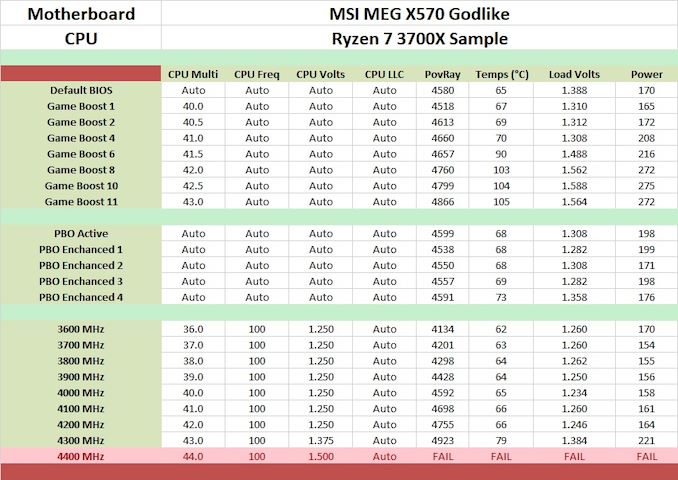The MSI MEG X570 Godlike Motherboard Review: Thor's Flagship
by Gavin Bonshor on August 28, 2019 12:00 PM EST- Posted in
- Motherboards
- AMD
- MSI
- 10G Ethernet
- Ryzen
- PCIe 4.0
- Ryzen 3000
- X570
- X570 Godlike
- MEG
Overclocking Ryzen 3000
Experience with the MSI MEG X570 Godlike
Overclocking with the Ryzen 3000 series hasn't exactly titillated users since its launch with there not being much headroom available. The biggest issue with this boils down to all-core overclocks being limited by the worst core of the chip. and the new 7 nm processors running quite warm. To get the best experience and results with the Ryzen 3000, users with good quality AIOs and custom water cooling yields the best outcome, and even with voltages of 1.375 V, these chips can run a little too warm for comfort.
The MSI Click BIOS 5 firmware is familiar to us and throughout the different chipsets including X399, X470, and Z390, the MSI MEG X570 Godlike uses the same design layout and setup. Within the OC section of the firmware, users can alter important settings such as the CPU ratio which can be changed in steps of 0.25 MHz, with relevant settings including CPU VCore, CPU Base Clock, and even FCLK frequency. Deeper into the firmware is settings to set the load line calibration (LLC) to a more aggressive or liberal profile, as well as all the Precision Boost Overdrive (PBO) settings.
The three main settings that PBO works from include package power tracking (PPT), thermal design current (TDC), and the electrical design current (EDC). All three of these can be set within the firmware under the advanced section of the Precision Boost Overdrive menu, although MSI has included four different PBO profiles for users to select from. The higher the setting, the higher the thermal and power draw will be, and it may not necessarily matter if a sub-par cooler is installed; it's noted that Ryzen 3000 processors work better when they are cooler.
There are seven different MSI Game Boost profiles to select from and users can access them via the dial at the bottom of the board, or through the firmware itself. The Game Boost profiles within the firmware can be accessed through the dial in the top left-hand corner. These profiles range from 4.0 GHz through to 4.3 GHz, and we've tested each of them below.
Overclocking Methodology
Our standard overclocking methodology is as follows. We select the automatic overclock options and test for stability with POV-Ray and OCCT to simulate high-end workloads. These stability tests aim to catch any immediate causes for memory or CPU errors.
For manual overclocks, based on the information gathered from the previous testing, starts off at a nominal voltage and CPU multiplier, and the multiplier is increased until the stability tests are failed. The CPU voltage is increased gradually until the stability tests are passed, and the process repeated until the motherboard reduces the multiplier automatically (due to safety protocol) or the CPU temperature reaches a stupidly high level (105ºC+). Our testbed is not in a case, which should push overclocks higher with fresher (cooler) air.
Overclocking Results
As it currently stands, MSI's Game Boost overclocking profiles need quite a bit of refinement, something they have informed us that these will be rectified with a new firmware revision; we will test this when we receive the board back from MSI. The issue with these is CPU VCore, or in a nutshell, too much of it which cross the board into the unsafe territory of the Ryzen 3000 processors safety limits; both in CPU VCore and in temperature. When we activated PBO and MSI's preset profiles for this, it didn't make much of an impact over the stock settings, which seems to be a reoccurring issue so far across the range of models we have tested so far.
Manually overclocking the MSI MEG X570 Godlike proved very fruitful and we managed to hit what seems to be the limits of our Ryzen 7 3700X testbed CPU with an overclock of 4.3 GHz all-cores with a CPU VCore of 1.35 V, which seems to be the brick wall for our processor. Even with a CPU VCore of 1.50 V, we couldn't get 4.4 GHz to remain stable when any kind of semi-intensive load was placed on the processor, although we did manage to boot into Windows 10 without fanfare with these settings. The performance wasn't throttled in POV-Ray throughout each of the frequencies tested and once the temperature limit of 110ºC is exceeded, the system will safely shut down. From 3.6 to 4.2 GHz, we managed to do this with a set CPU VCore of 1.250 V which did fluctuate slightly under load under the auto LLC setting. It is safe to say that the MSI MEG X570 Godlike doesn't have a VDroop issue and even at 4.3 GHz, a set CPU VCore of 1.375 resulted in a maximum load voltage of 1.384 V which isn't too far off the mark.













116 Comments
View All Comments
web2dot0 - Wednesday, August 28, 2019 - link
At this price. Get an Epyc 7302P and an MB that goes with it. 128Lanes of PCIE4.0.DigitalFreak - Wednesday, August 28, 2019 - link
But then you are missing out on the wonderful RGBeees!Kevin G - Wednesday, August 28, 2019 - link
The Ryzen parts should run at higher clocks than the low core count Epyc chips so there is a bit of a performance trade off. If that is acceptable and/or you need lots of fast IO, a low core count Epyc system would indeed be the better choice in this price range. The big catch is that Epyc server boards don't have things like on board audio which is pretty much expected for consumer parts.The real varible will be where the next Thread Ripper parts land in cores, clocks and dollars.
austinsguitar - Wednesday, August 28, 2019 - link
that rear io is NOT ACCEPTABLE!Orange_Swan - Wednesday, August 28, 2019 - link
yeah, that's what i was thinkingAndy Chow - Wednesday, August 28, 2019 - link
Finally a x570 board that does not have HDMI/DP ports which are completely ridiculous for 80%+ of people buying rizen CPUs. However, they replace that by nothing. Dual Realtek ALC1220 HD? No one will use that. And five (5!!!!) usb ports? How much is that board again?Tunnah - Wednesday, August 28, 2019 - link
lol holy crap, check the difference between game boost 2 and 11. Povray 4613, 172w. For an extra 5% performance you need 36c, 0.25v, and 100w, or about 60% more, power!They really did squeeze all they could out of this. I wish people would get past the clock speeds, or voltages, or power usage, etc. differences and just focus on the performance PER clock PER watt. This is just an exciting time for CPUs, and doubly exciting as a consumer!
hansmuff - Wednesday, August 28, 2019 - link
If I'm gonna spend that amount, I want to fan-free Gigabyte board.yetanotherhuman - Thursday, August 29, 2019 - link
Right?Qasar - Thursday, August 29, 2019 - link
have you even heard the fan on the board ?? unless you have.. complaining about the fan, is moot, as the noise it makes, may be drowned out, buy the other fans in your system.